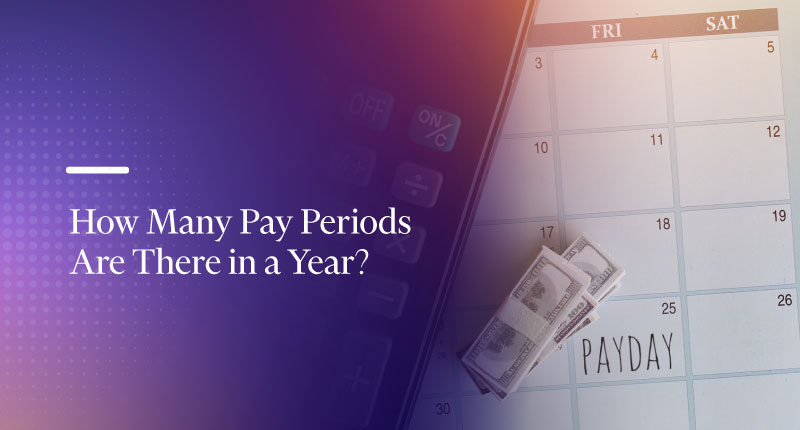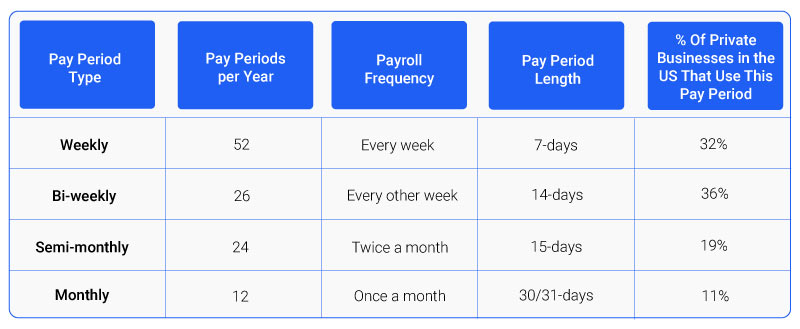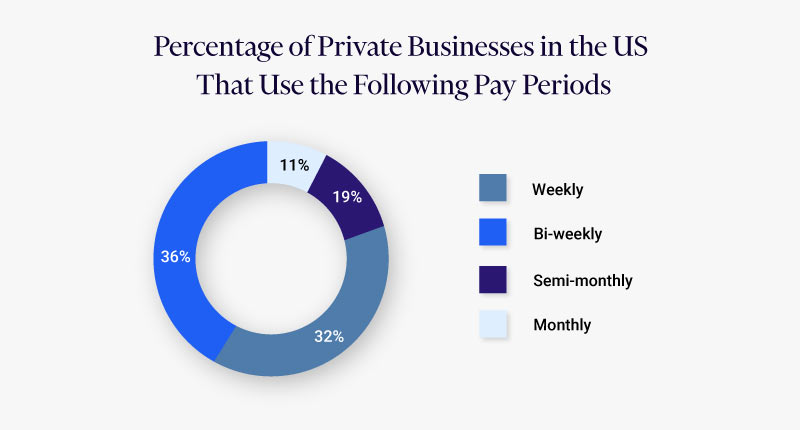What Is a Pay Period & How Many Pay Periods Are in a Year?

As part of running a business, it is important that you pay your employees consistently and on a pre-defined date. The on-time payments help them plan their budget and keep you compliant with rules and regulations of the Fair Labor Standards Act (FLSA). To help you understand this in depth, this blog will dive deep into the concept of pay periods and explore how many pay periods are there in a year.
What Is a Pay Period?
A pay period is a recurring timeframe in which employees are paid for the hours they work in the form of a wage or salary. An employer can choose a weekly, biweekly, semi-monthly, or monthly pay period system for its employees.
For example, in a weekly payroll period, employers run the payroll every week to pay for the hours that employees work in a week.
During the pay period, an employee’s work hours are tracked, and their pay is calculated based on hourly pay rate/fixed compensation, overtime pay (if any), tax deductions, insurance, and other allowances. After the tax deduction and inclusion of other benefits, the final amount is paid as a paycheck to employees.
No matter what type of payroll period employers opt for, they must deliver paychecks consistently on the stipulated pay date; otherwise, it can land them in trouble with the FLSA (Fair Labor Standards Act) complaints and penalties.
How Many Pay Periods Are in a Year?
The number of pay periods in a year can vary as per the organization’s payroll schedule, i.e., how frequently they issue the paycheck.
An employer can choose to run payroll on a monthly, weekly, biweekly, or semi-monthly basis. Among these pay schedules, biweekly is the most common payroll schedule in the United States, as per the U.S. Bureau of Labor Statistics.
| Pay Schedule | Total Pay Periods |
| Weekly | 52 |
| Biweekly | 26 |
| Semi-monthly | 24 |
| Monthly | 12 |
A year has 52 weeks thus, if an employer follows the weekly pay schedule, then there will be a total of 52 pay periods in a year. If they consider a biweekly pay schedule, there will be 26 pay periods in total.
On the other hand, with 12 months in a year, if an employer follows a monthly pay schedule, then a total of 12 pay periods will be there in a year and 24 pay periods if they choose to go with a semi-monthly pay schedule.
Note: The numbers of pay periods for each schedule type can vary slightly due to leap years and start/end dates of the payroll year (especially for weekly and biweekly).
The 365 days of a year don’t divide equally into 7-day weeks (52×7=364 days). If the payday comes during that extra day of the calendar year, it’ll result in 53 payroll periods for weekly and 27 payroll periods for biweekly schedules.
Similarly, during a leap year, you have one more leap day to deal with apart from that extra day. So, if your payday falls during one of these days, you’ll have an additional pay period that year.
Let’s understand the number of pay periods in a year for different pay schedules in detail.
Types of Pay Periods and the Frequency of Paychecks
Weekly Pay Period
As the name suggests, employees are paid once a week in a weekly pay period, which helps them cover their immediate expenses. If an organization chooses to pay employees weekly, they’ll pay their employees 52 times in a standard year or 53 times in leap years as per the number of weeks.
Also, the conventional workdays are from Monday to Friday, i.e., five days long; however, the weekly pay period is considered seven days long.
Employees like this payroll schedule since it provides consistent cash flow. This payroll system is best suited for hourly employees whose daily schedules change frequently.
Note: The weekly pay period is beneficial for employees who frequently do overtime. They mostly log their work hours for a week in the timesheet and get the pay as per the regular and overtime hours worked that week.
| Pay Period Length | How Many Weekly Pay Periods in a Year |
| 7 days | 52 |
Example: January 1 to January 7
Industries: Weekly pay periods are majorly used in the sectors involving manual labor, such as construction, manufacturing, mining, and hospitality.
|
Did you know? In the US, 32% of private businesses use the weekly pay period for their employees. |
Advantages of Weekly Pay
- Employees get frequent pay, which helps them meet their immediate expenses easily.
- This pay period is best suited for employees who work overtime every other day.
- The alignment with workweek makes this pay period an easier option to comply with FLSA overtime pay laws
Disadvantages of Weekly Pay
- The administration will have to run the payroll every other week, which is time-consuming.
- This pay period increases the administrative costs for the employers as the payroll is processed each week.
Biweekly Pay Period
The biweekly pay period is two weeks long, i.e., 14 days. Therefore, employers who choose the biweekly payroll period will have to provide 26 paychecks to employees per year.
Here, employees are paid every two weeks, on a specified day of the two weeks, e.g., every other Saturday.
This pay period is better than the weekly one, as administrative workers will have less frequent payroll processing. On top of that, employees can still get payments consistently without waiting too long. This payroll system balances the frequent payroll processing of weekly pay periods and the large gaps in the monthly pay periods.
Note: In a biweekly pay period, the payment is made every two weeks. But, a month can’t be strictly divided into two payroll periods (14+14=28), and 2 to 3 days aren’t covered in the two payroll cycles.
As a result, there’s a possibility of a third payroll run in a certain month. In such rare cases, a year will have 27 pay periods rather than 26. So employers should check the possibility of such occurrences in the payroll calendar to avoid any conflict later.
| Pay Period Length | How Many Biweekly Pay Periods in a Year |
| 14 days | 26 |
Example: January 1 to January 14
Industries: It’s widely adopted by the education and healthcare services, hospitality, mining & logging, and information industries.
|
Did you know? This payroll period is the most adopted schedule in the US. In fact, 36% of US businesses pay their employees on a biweekly basis. |
Advantages of Biweekly Pay
- It’s more cost-effective than weekly.
- This pay period is quite predictable for employees as the paycheck is issued on the same day every two weeks.
- It’s less hectic and more time-saving than the weekly payroll schedule.
- Employees can plan their budget easily as they receive their paychecks every other week.
- This system can be suitable for ecommerce business owners having fewer recurring monthly expenses.
Disadvantages of Biweekly Pay
- Payroll processing and calculation can become cumbersome for the months that may require payroll processing for three cycles. That’s because the payroll period of a month can extend into the next month due to 2-week cycles.
- The biweekly pay isn’t as costly as the weekly ones, but the number of pay cycles is still quite enough to increase the cost of processing payroll.
Semi-monthly Pay
In a semi-monthly pay period, employees are paid 24 times a year. This payroll calendar runs from the 1st of the month till the 15th and then from the 16th to the 30th/31st. This way, employees are paid twice a month in this pay schedule, usually on the 1st and 15th of a month or the 15th and last day of the month.
This payroll system is widely used for salaried employees with regular work schedules. Though payroll processing is pretty straightforward for employers, calculating overtime can be a bit challenging.
Plus, in this type of pay cycle, the pay date is likely to fall on a weekend. For such situations, employers usually pay their employees on the closest business day before that particular weekend.
| Pay Period Length | How Many Semi Monthly Pay Periods in a Year |
| 15 days | 24 |
Example: January 1 to January 15, or January 16 to January 31
Industries: This pay period is popularly used for salaried professionals working in finance, information, and professional services.
|
Did you know? 19% of the private businesses in the US prefer the semi-monthly payroll period to process employees’ payroll. |
Advantages of Semi-monthly Pay
- Processing and calculating payroll is pretty straightforward.
- Employees enjoy consistent paychecks on a fixed date that helps them plan their budget and meet their expenses immediately.
Disadvantages of Semi-monthly Pay
- Calculating overtime can sometimes be difficult, as pay periods don’t align with weekdays.
- The payroll calendar may need some adjustments if the pay date falls on the weekends.
- Payroll gets processed on a different weekday every time.
Monthly Pay Period
Employees are paid once a month on a stipulated date each month as part of this system. Thus, employees receive 12 paychecks in a year.
The pay date is usually the first or last day of the month, but it can vary according to the employee’s preference or company cash flow.
Monthly pay periods create the least hectic schedule for administrative staff, considering payrolls need to run only once a month. However, the same isn’t applicable to employees, especially in low-wage industries, as they have to wait longer to get their paychecks.
| Pay Period Length | How Many Monthly Pay Periods in a Year |
| 30 days | 12 |
Example: January 1 to January 31
Industries: It’s popularly used in professional and business services, freelance writing, and financial sectors.
|
Did you know? The monthly payroll system isn’t very popular in the US due to its long intervals, and is used by around 11% of the private businesses. |
Advantages of Monthly Pay
- The monthly payroll period reduces the payroll cost and administrative burden as payroll is processed only once a month.
- Accrual expenses are easy to calculate as the hours worked remain the same each month.
Disadvantages of Monthly Pay
- Employees have to wait longer to get their compensation in the monthly payroll system. This is especially a concern for low-wage salaried workers with little savings.
- Monthly pay is easy to calculate, but overtime calculations can be tricky.
- The month-end expenses can be hard to meet for employees.

How to Determine Which Pay Period Is Best for You
Employers must choose the payroll period that favors them as well as their employees. Following an inappropriate pay period can result in employee dissatisfaction and turnover. Here are some points that you should consider while choosing the best pay period for payroll processing.
Look for the Industry Standards
The type of industry plays a crucial role in determining which payroll period will be the best, as some industries have adopted a specific payroll period as a standard, and all businesses in similar industries use it.
For example, most hospitality and education industries use weekly cycles for running payroll.
Check Your Employee’s Preference
The pay period should suit both employer and employee. Employers can discuss with employees or conduct surveys to know their preferences. Mostly, employees prefer frequent paychecks to meet their expenses; however, some executive or managerial employees may find the monthly paychecks convenient too.

Consider the Company Size
While ascertaining the best payroll period for your company, you should also keep the size of your company in mind. For example, if you have a small staff of around 50-100 employees, you can easily opt for a weekly or biweekly schedule. On the other hand, if your company’s workforce size is 500+, then a monthly payroll system will be a better option.
See the Administration Capacity
Frequent payroll processing means more work for the administrative department and increased administration costs. Using monthly or semi-monthly pay periods will do the trick if you have a small admin team.
If you use a weekly pay cycle for employees, and your administrative team doesn’t have the bandwidth to process it every week, it may lead to payroll errors and staff burnout.
Check the Cash Flow
As an employer, you should ensure that the choice of payroll system resonates with your financial planning.
Suppose you have a small startup with a tight cash flow; opting for semi-monthly or monthly will be the best option. This way, you can always make sure that you can process payroll promptly without facing any cash flow shortage.
Moreover, if your client pays you at the end of the month, you can set the pay date accordingly.

Keep a Tab on State Employment Law
Before making a final call on the pay period to adopt, check the current payday frequency laws for the country and state as applicable. Suppose you prefer to pay your employees monthly; however, the state law mandates at least biweekly payments. In such cases, not working according to the local laws can result in penalties.
For example, in Maine, employers must run payroll once every 16 days at least. Hence, employers in Maine can’t opt for the monthly payroll cycle in this state. So stay abreast of employment laws to ensure that your payroll period doesn’t contravene the regulations and land you into unnecessary litigations.
Consider the Payment Method
The type of payment mode you prefer for payroll processing also plays a vital role in determining the pay period. For example, a weekly payroll period won’t be ideal if you pay your employees via check. That’s because weekly pay requires you to run payroll frequently, and writing copious numbers of paychecks will take a lot of time.
Most Popular Pay Period in Different Countries
- In the US, a biweekly payroll cycle is most popular among employers, followed by a weekly one.

- A monthly pay period in the UK is most common, with salary disbursed between the 25th and 30th of each month. Besides, semi-monthly and weekly pay periods are also followed by some employers.
- In Australia, a fortnightly/biweekly payroll system is widely used by companies. However, employers also use weekly and monthly pay periods apart from the biweekly.
- In India, the monthly payroll system is the most popular, with payroll periods from the 1st to 30/31st.
- In Canada, employers are free to opt for weekly, biweekly, semi-monthly, or monthly schedules to disburse payment. However, the monthly payment schedule is the least common payroll cycle there.
- In Russia, it’s mandated to pay salaries at least every half month on a specified day; thus, semi-monthly is the most popular payroll period.
- In Europe, most salaried employees receive salaries as per a monthly payroll period system.
Bottom Line
Before adopting any payroll period, it’s advised to inform your employees with an advance notice. Such prior notice will help them adjust their budget and expenses accordingly, especially when you plan to decrease the pay frequency (e.g., biweekly to monthly).
Always have a brainstorming session with employees and educate them about how this payroll period would work, when they’ll receive their paychecks, what about additional pay cycles in leap years, etc. Having an open line of communication and allowing employees to share their personal preferences is the key to successfully running a payroll system. It’s also essential for attracting and retaining top talent in your organization.






